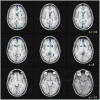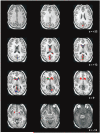Striatal outcome processing in healthy aging
- PMID: 18814467
- PMCID: PMC2597105
- DOI: 10.3758/cabn.8.3.304
Striatal outcome processing in healthy aging
Abstract
Functional MRI of young adults has implicated the striatum in the processing of rewarding and punishing events. To date, only two published experiments (Samanez-Larkin et al., 2007; Schott et al., 2007) have explored similar phenomena in older adults, with both studies emphasizing the anticipation of monetary outcomes. To better understand older participants' striatal responses to delivered outcomes, we engaged 20 older adults and 13 younger adults in a card-guessing task that rewarded correct guesses with monetary gain and punished incorrect guesses with monetary loss. Overall, the older adults retained most of the typical features of the striatal response, so that activity in the caudate head showed reliable differentiation between rewards and punishments during the 6- to 9-sec postoutcome window. Comparison of the older and younger adults also pointed to some potential aging effects on outcome activity, including reductions in the magnitude and extent of striatal activation, and a trend for the older adults to show a decreased early punishment response. In sum, our data suggest that the signaling of outcome valence remains relatively stable into late adulthood, although more research is needed to understand some subtle changes that might occur across the life span.
Figures






References
-
- Aizenstein HJ, Clark KA, Butters MA, Cochran J, Stenger VA, Meltzer CC, et al. The BOLD hemodynamic response in healthy aging. Journal of Cognitive Neuroscience. 2004;16:786–793. - PubMed
-
- Bäckman L, Ginovart N, Dixon RA, Wahlin T-B, Wahlin Å, Halldin C, Farde L. Age-related cognitive deficits mediated by changes in the striatal dopamine system. American Journal of Psychiatry. 2000;157:635–637. - PubMed
-
- Bäckman L, Nyberg L, Lindenberger U, Li S-C, Farde L. The correlative triad among aging, dopamine, and cognition: Current status and future prospects. Neuroscience & Biobehavioral Reviews. 2006;30:791–807. - PubMed
-
- Beck AT, Steer RA, Brown GK. Manual for the Beck Depression Inventory. 2nd ed. Psychological Corporation; San Antonio, TX: 1996.
Publication types
MeSH terms
Grants and funding
LinkOut - more resources
Full Text Sources
Medical
